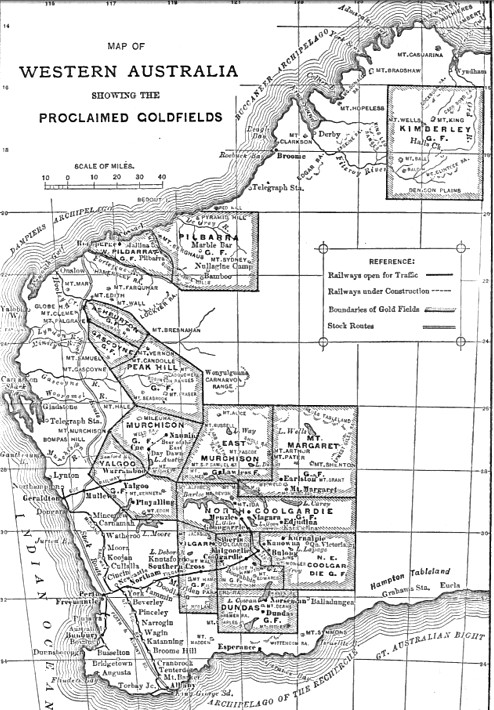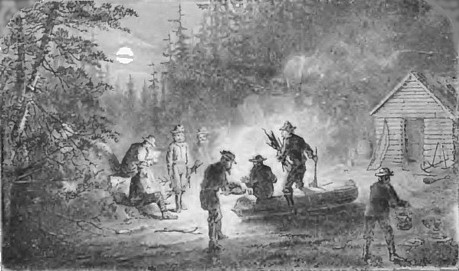The peculiar character of these "gold rushes" is directly traceable to the nature of the gold-occurrence. Gold is found lying on the very top of the ground, and the first surface-mining yields extraordinary profits. The search for the particles of gold scattered over the surface is called “specking." In the early days hundreds of ounces were thus picked up in a few hours by the men first to reach a rich spot. When the cream has thus been skimmed off, the sandy soil underneath is treated, the dirt being winnowed by pouring it from one pan into another. After that, actual digging begins, the shallow deposits being trenched and pitted in the search for those patches of rich ground through which the gold is found sporadically distributed. "Specking" is still a recognized occupation on Sundays, even at the established mining centers. I have seen as many as a hundred men walking about with their hands in their pockets and their eyes intent on the ground, for all the world as if they were in disgrace. A five-ounce nugget may be found ; and everyone hastens to the spot. Perhaps nothing more is picked up; or it may be that sufficient natural gold is discovered to attract troops of "dry-blowers" to the place.
The "dry-blower" is brother to the "gulch-miner" of America and the " alluvial digger" of the eastern colonies of Australia. In the investigation of the methods of the dry-blower and the occurrence of the deposits out of which he wins the gold, I observed many facts of such interest, it seemed to me, as to warrant the preparation of this contribution to the Transactions of our Institute. In mountainous regions the disintegration of the surface is mainly caused by the frost. Water penetrates into crevices and cracks, and, because its maximum density is at 4 C. and not at zero, it undergoes such expansion in the immediate approach to the freezing-point as to become a powerful lever for tearing the rocks apart. Thus is loosened that material out of which eventually the alluvial deposits of the valley are formed. In warmer climates the contraction and expansion of water is likewise a ceaselessly destructive agent. Even in a dry, hot, region, such as the interior of West Australia, the difference between the heat of day and the cold of night causes the dew to play an important part in molding the physiography of the country. For it must be remembered that the changes of volume caused, in water as in other substances, by changes of temperature, are well-nigh irresistible in energy, however minute in amount. The cool nights, which alone make life bearable on the Coolgardie gold-fields, are thus beneficent in two ways. To them is ultimately owing the formation of those accumulations of gold-bearing dirt out of which many a prospector has dug himself a competence for life. The tables on page 10 from the government meteorological reports exhibit this variation in temperature.
In mountainous lands the melting of the winter snows yields the water employed in that process of concentration which begins as soon as the rock is shattered, and continues until each ultimate particle has been classified by the untiring machinery of nature. The "tailings" are the mud and sand which go to build new continents upon the ocean-floor, the "middlings" are the great masses of alluvium covering the plain, and the "heads" are the gold-bearing gravels of the mountain valley. The soft is separated from the hard, the heavy from the light, until at length the metal once incased in quartz and enclosed within the rock is set free, to be collected wherever the eager stream has so abated its force as to permit the particles of gold to find a quiet resting-place. It is a great sifting-process. The motion of the water is governed by the slope of the surface. In a flat country the conditions resemble those surrounding a mill so situated as to be incapable of getting rid of its accumulating tailings. Should the water-supply of the mill also prove insufficient to carry out its operations, then the analogy with a desert plateau is complete. The process of concentration must in both cases remain unfinished.
The gold-bearing gravels of California and Victoria, for example, usually rest on a hard bed-rock, whose water-worn surface speaks of the agency which made it so. The particles of gold and heavy iron-sand have been washed clean ; the overlying pebbles and quartz gravel are comparatively free from material less resisting than themselves ; and, if there be any clay, it is found in distinct layers, in positions testifying to the variations in the velocity and volume of the stream which laid down the deposit as a whole. It is an orderly arrangement of assorted material.Compare this with the alluvium of the desert. A low ridge is crested with the outcrop of a gold bearing quartz vein which, amid that surrounding sea of dark blue scrub justifies its colonial designation as a “reef”. On its flanks there is a thin cover of sandy soil which gradually thickens, a little lower down the slope, to a deposit of several feet. Sink a hole and you will find, first an inch or two of loose sand and dust, then a more solid layer of gravel and dirt, which in turn passes imperceptibly into a compact material consisting of fragments of rock and quartz, held firmly together by clay. It is called "cement," and it might better be termed an "agglomerate". It is an unclassified product of erosion, and lies close to the place of its origin, as a mere collection of unsorted debris.
The rock on which the deposit rests is so softened by decomposition that it is frequently taken for a part of the overlying detritus. If the hole be continued so as to become a well or shaft, it will penetrate through additional oxidized ground until this suddenly gives place to diorite or granite (the two prevailing formations) at a depth varying from 75 to 200 feet, which is the drainage-level of the region. This deposit owes its existence to the wind and rain, assisted by gravity acting on a slightly inclined surface. Wind is ordinarily an insignificant geological agent, but in the constant and violent draughts of a high plateau there is a force which, working during long periods of time, is capable of producing notable results. In the vicinity of Coolgardie and Kalgoorlie, especially the latter, which has the less broken topography, the dust-storms are almost ceaseless, and bear forceful testimony to the amount of material which can be conveyed in the air. The wind careers over the country in gyrating whirls, to which the aborigines give the name of "willy-willy," and have the white invaders ventured to call them otherwise. These whirlwinds go waltzing across the wretched town, they gather up in their skirts all the scattered refuse of a border civilization. I formed the impression that the wind had a prevailing direction from the southeast to the northwest, that is, from the nearest sea toward the heated interior; but the meteorological reports of the government do not confirm this supposition. In the accompanying table, Beaufort's scale of wind-force is employed. It will be observed that the meteorological reports confirm the impression that Kalgoorlie is more windy than Coolgardie, and that a quiet condition of the atmosphere is unusual in both districts. Nor is there any consistency of direction, as is proved by the observations made, for example, at Kalgoorlie during the month of September, 1897. It is evident that the wind blew where it listed, and no man could tell whence it came.
Observations necessarily fail to record the really characteristic play of the wind in this region. The whirl-storms, referred to already, spring up suddenly, rush madly across the plain, suck up everything lying loose on the surface, arid as suddenly subside. These apparently erratic air-disturbances are responsible for the transport of the greater part of the material which weathering and erosion have disintegrated. So far as I know, measurements of the transporting-power of the wind have not been made in this particular region; but elsewhere in Australia scattered observations have been made; for example, that fences 4 feet high are buried by drifting sand in a period only slightly exceeding two years. In the Libyan desert, bordering the Kile valley, the same results can be seen. Thus, for instance, the sand-storms bury the temple of the Sphinx every summer, and the road built by Ismail Pasha, from the Mena House to the Pyramids, is filled with sand up to the level of the 6-foot parapet in less than ten days.
Continue on to:
The Alluvial Deposits of Western Australia, Part IV
Return To:
Important Gold Mining Regions Worldwide


